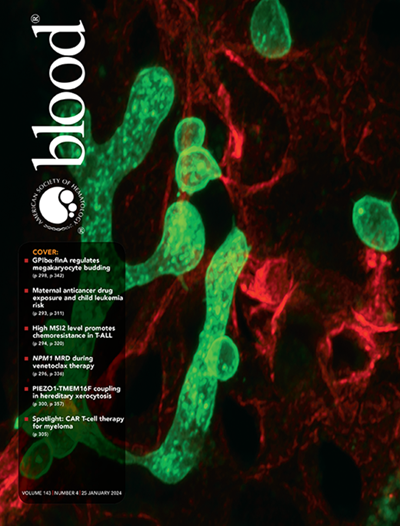慢性淋巴细胞白血病中lef1蛋白水平升高和异构体转换驱动细胞增殖。
IF 23.1
1区 医学
Q1 HEMATOLOGY
引用次数: 0
摘要
转录因子LEF1在慢性淋巴细胞白血病(CLL)的所有亚型和分期中都异常表达,但其在CLL发病机制中的分子机制仍不清楚。在这里,我们通过对患者来源的样本进行广泛的功能分析,对CLL中LEF1功能进行了全面的机制解剖。我们发现,尽管LEF1 mRNA水平保持稳定,但临床侵袭性病例显示,由于蛋白质稳定性增强,LEF1蛋白水平升高。LEF1蛋白丰度被淋巴结源性刺激选择性调节,包括t细胞相互作用和b细胞受体(BCR)信号。重要的是,我们发现了由其蛋白水平决定的LEF1的双重上下文依赖作用。低LEF1蛋白是惰性病例的特征,支持b细胞活化,而侵袭性疾病中蛋白丰度的增加通过结合和诱导细胞周期和代谢基因网络促进增殖。我们进一步发现,在增殖性和侵袭性CLL中,LEF1外显子6跳变丰富。体外和体内实验都表明,lef1驱动的增殖是由这些短的、可选择的剪接异构体介导的。虽然所有的LEF1亚型都与一组核心的增殖和激活相关基因结合,但它们诱导不同的转录程序:全长LEF1促进静止基因标记并限制白血病生长,而外显子6跳脱亚型则驱动增殖。我们的研究结果表明,在CLL中,LEF1是一个致癌转录因子,其生物学和临床效应在转录后受到蛋白质丰度和同型异构体组成的调节。本文章由计算机程序翻译,如有差异,请以英文原文为准。
INCREASED LEF1 PROTEIN LEVELS AND ISOFORM SWITCHING DRIVE CELL PROLIFERATION IN CHRONIC LYMPHOCYTIC LEUKEMIA.
The transcription factor LEF1 is aberrantly expressed across all subtypes and stages of chronic lymphocytic leukemia (CLL), yet the molecular mechanisms underlying its contribution to CLL pathogenesis remain poorly defined. Here, we conducted a comprehensive mechanistic dissection of LEF1 function in CLL using extensive functional analyses of patient-derived samples. We identified that, although LEF1 mRNA levels remain stable, clinically aggressive cases show elevated LEF1 protein levels due to enhanced protein stability. LEF1 protein abundance is selectively modulated by lymph node-derived stimuli, including T-cell interactions and B-cell receptor (BCR) signaling. Importantly, we uncovered a dual, context-dependent role for LEF1 that is determined by its protein levels. Low LEF1 protein, characteristic of indolent cases, supports B-cell activation, while increased protein abundance in aggressive disease promotes proliferation through the binding and induction of cell cycle and metabolic gene networks. We further showed that LEF1 exon 6 skipping is enriched in proliferative and aggressive CLL. Both in vitro and in vivo experiments revealed that LEF1-driven proliferation is mediated by these short, alternative spliced isoforms. While all LEF1 isoforms bind to a core set of proliferation- and activation-related genes, they induce distinct transcriptional programs: full-length LEF1 promotes a quiescence gene signature and limits leukemic growth, whereas exon 6-skipping isoforms drive proliferation. Our findings establish LEF1 as an oncogenic transcription factor in CLL whose biological and clinical effects are modulated post-transcriptionally by both protein abundance and isoform composition.
求助全文
通过发布文献求助,成功后即可免费获取论文全文。
去求助
来源期刊

Blood
医学-血液学
CiteScore
23.60
自引率
3.90%
发文量
955
审稿时长
1 months
期刊介绍:
Blood, the official journal of the American Society of Hematology, published online and in print, provides an international forum for the publication of original articles describing basic laboratory, translational, and clinical investigations in hematology. Primary research articles will be published under the following scientific categories: Clinical Trials and Observations; Gene Therapy; Hematopoiesis and Stem Cells; Immunobiology and Immunotherapy scope; Myeloid Neoplasia; Lymphoid Neoplasia; Phagocytes, Granulocytes and Myelopoiesis; Platelets and Thrombopoiesis; Red Cells, Iron and Erythropoiesis; Thrombosis and Hemostasis; Transfusion Medicine; Transplantation; and Vascular Biology. Papers can be listed under more than one category as appropriate.
 求助内容:
求助内容: 应助结果提醒方式:
应助结果提醒方式:


